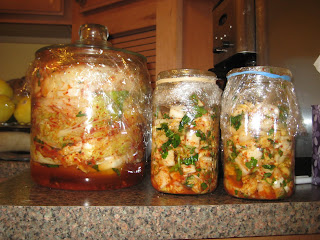

Kimchi, the ubiquitous and varied pickle of Korea, is a classic seasonal dish. From what I have heard and read, November is the time that home cooks prepare the large vats of the pickle that will sustain their families' palates throughout the coming year. As a cook, I am a newcomer to the world of kimchi, having mostly dabbled in cabbages and radishes, although there seems to be a recipe for almost any vegetable one can grow or forage. No matter what the item being pickled, or the level of seasoning, kimchi is invariably a revelation of bright, pungent flavors. For me, it is an effervescent reminder that seasonal, local eating need not mean a dull experience.
All too often, I am put off by the earnestness of the "local eating" movement, especially regarding salt and spices. I am weary of the food writers who, having "discovered" seasonal produce, instruct cooks and eaters alike to honor the beauty of the vegetable by serving it lightly steamed on a plate with the barest of seasoning. Does this approach make the preparation and consumption of the produce any more virtuous or "authentic"? Several years ago, I pored over a found copy of Living the Good Life by the proto-back-to-the-landers Helen and Scott Nearing. While I found their life and philosophy thrilling, I did sigh at the scenes of their dinners. Who among us really wants to sit around with earnest locovores eating unseasoned lettuce from a wooden bowl and extolling the inherent flavors of the leaves? When my husband and I went to Chez Panisse for the first time several years ago, we looked about at our fellow diners thrilling to the "natural" flavor of the beans and squash and began to think that maybe the emperor had no clothes. We were paying over hundred bucks for what was fundamentally under-seasoned but excellent garden produce.
Enter kimchi -- a firm rebuke to any under-seasoned earnestness. Today I made three types, from the article recently published in Saveur ( http://www.saveur.com/article/Kitchen/The-Art-of-Kimchi ). Yesterday, we spent a long morning at the local Korean mecca, Super-H Mart, finding salted shrimp and the right type of radish. It can be a little daunting to look at 10 pounds of cabbage and radishes and realize that I am but a dilettante in this culinary world of pickling --some families have entire refrigerators just to store their kimchi. Of course, I do not serve it at every meal. I have a half-cup or so left of this last year's batch, which I will be stir-frying with shiitakes and slivers of beef for dinner tonight. That is a stand-by meal for us, as are the bright little Korean vegetable pancakes bursting with kimchi that have entirely replaced German potato pancakes in our family (sorry, Mom). Finally, while this may not be "authentic", once you replace dill pickles with kimchi on your hamburgers, you will never look back.
I do appreciate that Saveur took the time to write a long, passionate article about the preparation of this traditional dish. It did cause a cringe-inducing moment for me though, with its quick mention of North Korea and the challenges of finding places to sample the traditional pickle of that region. Food writing can often ignore the political reality of food preparation, and the human toll of starvation and famine. One need to look no further than the horrifying story recently featured in The New Yorker (http://www.newyorker.com/reporting/2009/11/02/091102fa_fact_demick ) to know that for many people access to even a daily staple like kimchi is a right no longer afforded by the current dictatorship. As I taste the product of my morning's efforts, I am sobered by the memory of my reading. The flavor is pungent, and there is a sharp swallow of grief to chase it down.
No comments:
Post a Comment